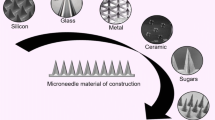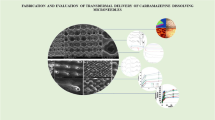Abstract
There is an increasing concern on the drug loading capacity of microneedles (MNs) to meet higher drug dosage requirement. The present study describes the fabrication of modified rapidly separating polyvinyl alcohol (PVA)-based MNs (RS-P-MNs) with high drug loading using a mechanical agitation process. The drugs encapsulated within the PVA polymer gel by mechanical agitation served as an encapsulating agent for drugs that provide a high drug loading capacity and also release of drugs in a controlled manner. The various parameters such as microscopic analysis, atomic force microscopy (AFM), drug loading, drug delivery efficiency, mechanical test, skin penetration ability, and in vitro and in vivo analyses indicate the great potential of the RS-P-MNs. The maximum drug loading capacity of RS-P-MNs was measured to be approximately 900 ng per microneedle, which was almost a hundred times than the traditional drug encapsulating mode. The in vitro and in vivo results suggested that the controlled release of drugs is due to the encapsulating mode (mechanical agitation) of drugs. The prepared RS-P-MNs with high drug loading in this study provided a gentle and controlled release of drugs instead of the robust release of drugs from traditional MNs.

Graphical abstract







Similar content being viewed by others
References
Garland MJ, Migalska K, Mazlelaa T, Mahmood T, Raghu T, Singh R, et al. Microneedle arrays as medical devices for enhanced transdermal drug delivery. Expert Rev Med Devices. 2011;8:459–82.
Donnelly RF, Singh TRR, Tunney MM, Morrow DIJ, McCarron PA, O’Mahony C, et al. Microneedle arrays allow lower microbial penetration than hypodermic needles in vitro. Pharm Res. 2009;26:2513–22.
Van der Maaden K, Jiskoot W, Bouwstra J. Microneedle technologies for (trans)dermal drug and vaccine delivery. J Control Release. 2012;161:645–55.
Weldon WC, Martin MP, Zarnitsyn V, Wang BZ, Koutsonanos D, Skountzou I, et al. Microneedle vaccination with stabilized recombinant influenza virus hemagglutinin induces improved protective immunity. Clin Vaccine Immunol. 2011;18:647–54.
Song JM, Kim YC, Lipatov AS, Pearton M, Davis CT, Yoo DG, et al. Microneedle delivery of H5N1 influenza virus-like particles to the skin induces long-lasting B- and T-cell responses in mice. Clin Vaccine Immunol. 2010;17:1381–9.
Ito Y, Hagiwara E, Saeki A, Sugioka N, Takada K. Feasibility of microneedles for percutaneous absorption of insulin. Eur J Pharm Sci. 2006;29:82–8.
Lee SG, Jeong JH, Lee KM, Jeong KH, Yang H, Kim M, et al. Nanostructured lipid carrier-loaded hyaluronic acid microneedles for controlled dermal delivery of a lipophilic molecule. Int J Nanomedicine. 2014;9:289–99.
Gill HS, Soderholm J, Prausnitz MR, Sallberg M. Cutaneous vaccination using microneedles coated with hepatitis C DNA vaccine. Gene Ther. 2010;17:811–4.
Bariya SH, Gohel MC, Mehta TA, Sharma OP. Microneedles: an emerging transdermal drug delivery system. J Pharm Pharmacol. 2012;64:11–29.
Escobar-Chavez JJ, Bonilla-Martinez D, Villegas-Gonzalez MA, Molina-Trinidad E, Casas-Alancaster N, Revilla-Vazquez AL. Microneedles: a valuable physical enhancer to increase transdermal drug delivery. J Clin Pharmacol. 2011;51:964–77.
Banga AK. Microporation applications for enhancing drug delivery. Expert Opin Drug Del. 2009;6:343–54.
Norman JJ, Brown MR, Raviele NA, Prausnitz MR, Felner EI. Faster pharmacokinetics and increased patient acceptance of intradermal insulin delivery using a single hollow microneedle in children and adolescents with type 1 diabetes. Pediatr Diabetes. 2013;14:459–65.
Norman JJ, Choi SO, Tong NT, Aiyar AR, Patel SR, Prausnitz MR, et al. Hollow microneedles for intradermal injection fabricated by sacrificial micromolding and selective electrodeposition. Biomed Microdevices. 2013;15:203–10.
Gill HS, Prausnitz MR. Coated microneedles for transdermal delivery. J Control Release. 2007;117:227–37.
Ito Y, Taniguchi M, Hayashi A, Anai M, Morita S, Ko E, et al. Application of dissolving microneedles to glucose monitoring through dermal interstitial fluid. Biol Pharm Bull. 2014;37:1776–81.
DeMuth PC, Garcia-Beltran WF, Ai-Ling ML, Hammond PT, Irvine DJ. Composite dissolving microneedles for coordinated control of antigen and adjuvant delivery kinetics in transcutaneous vaccination. Adv Funct Mater. 2013;23:161–72.
Hirobe S, Azukizawa H, Matsuo K, Zhai Y, Quan YS, Kamiyama F, et al. Development and clinical study of a self-dissolving microneedle patch for transcutaneous immunization device. Pharm Res. 2013;30:2664–74.
Ling MH, Chen MC. Dissolving polymer microneedle patches for rapid and efficient transdermal delivery of insulin to diabetic rats. Acta Biomater. 2013;9:8952–61.
Ma YZ, Boese SE, Luo Z, Nitin N, Gill HS. Drug coated microneedles for minimally-invasive treatment of oral carcinomas: development and in vitro evaluation. Biomed Microdevices. 2015;17:44.
Chu LY, Choi SO, Prausnitz MR. Fabrication of dissolving polymer microneedles for controlled drug encapsulation and delivery: bubble and pedestal microneedle designs. J Pharm Sci. 2010;99:4228–38.
Guo L, Chen JM, Qiu YQ, Zhang SH, Xu B, Gao YH. Enhanced transcutaneous immunization via dissolving microneedle array loaded with liposome encapsulated antigen and adjuvant. Int J Pharm. 2013;447:22–30.
DeMuth PC, Min Y, Irvine DJ, Hammond PT. Implantable silk composite microneedles for programmable vaccine release kinetics and enhanced immunogenicity in transcutaneous immunization. Adv Healthc Mater. 2014;3:47–58.
Sullivan SP, Murthy N, Prausnitz MR. Minimally invasive protein delivery with rapidly dissolving polymer microneedles. Adv Mater. 2008;20:933–8.
McCrudden MTC, Alkilani AZ, McCrudden CM, McAlister E, McCarthy HO, Woolfson AD, et al. Design and physicochemical characterisation of novel dissolving polymeric microneedle arrays for transdermal delivery of high dose, low molecular weight drugs. J Control Release. 2014;180:71–80.
Wang S, Jia ZX, Zhou XY, Zhou DB, Chen MZ, Xie D, et al. J Appl Polym Sci. 2017;134:8.
Laha A, Sharma CS, Majumdar S. Mater Sci Eng C Mater Biol Appl. 2017;76:782–6.
Wang QL, Zhu DD, Chen Y, Guo XD. A fabrication method of microneedle molds with controlled microstructures. Mater Sci Eng C-Mater Biol Appl. 2016;65:135–42.
Zhu DD, Wang QL, Liu XB, Guo XD. Rapidly separating microneedles for transdermal drug delivery. Acta Biomater. 2016;41:312–9.
Zhu DD, Chen BZ, He MC, Guo XD. Structural optimization of rapidly separating microneedles for efficient drug delivery. J Ind Eng Chem. 2017;51:178–84.
Funding
This work was financially supported by the National Natural Science Foundation of China (51673019, 51873015), the Fundamental Research Funds for the Central Universities and Research projects on biomedical transformation of China-Japan Friendship Hospital (PYBZ1817), and the long-term subsidy mechanism from the Ministry of Finance and the Ministry of Education of PRC.
Author information
Authors and Affiliations
Corresponding authors
Ethics declarations
All the animal studies were conducted in accordance with the guidelines of the Ethics Committee of Beijing University of Chemical Technology (BUCT), Beijing, China.
Conflict of interest
The authors declare that they have no conflict of interest.
Additional information
Publisher’s note
Springer Nature remains neutral with regard to jurisdictional claims in published maps and institutional affiliations.
Rights and permissions
About this article
Cite this article
Zhu, D.D., Zhang, X.P., Shen, C.B. et al. The maximum possible amount of drug in rapidly separating microneedles. Drug Deliv. and Transl. Res. 9, 1133–1142 (2019). https://doi.org/10.1007/s13346-019-00658-7
Published:
Issue Date:
DOI: https://doi.org/10.1007/s13346-019-00658-7




